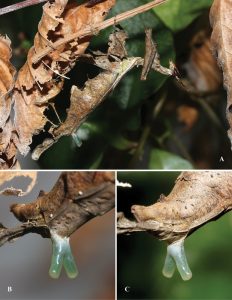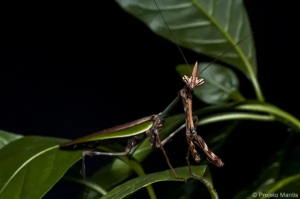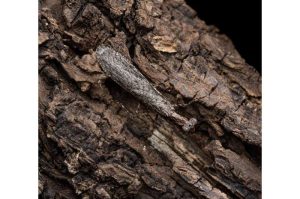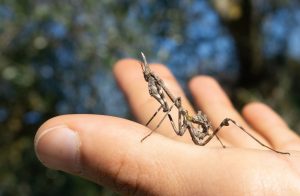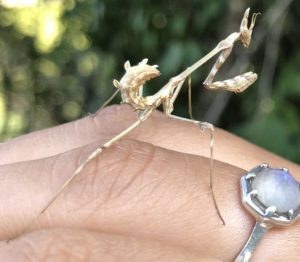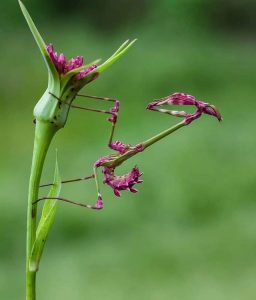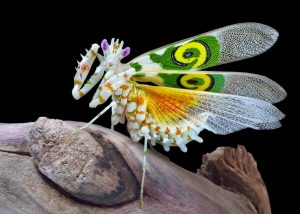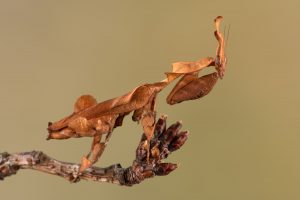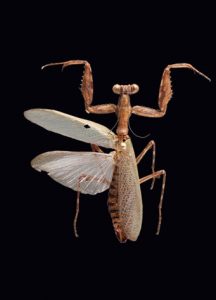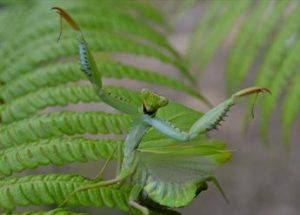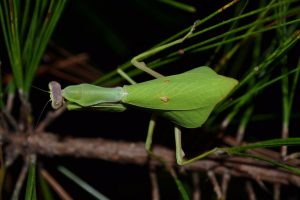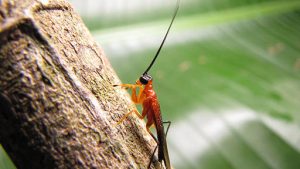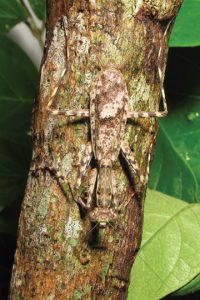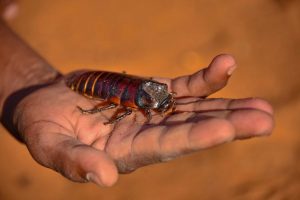Podcast: Play in new window | Download (Duration: 12:05 — 13.4MB)
Thanks to Kari and Joel for their suggestions this week! You can find Kari Lavelle’s excellent book Butt or Face? Volume 2: Revenge of the Butts at any bookstore.
Our Kickstarter for some enamel pins goes live in just over a week if you’re interested!
Further reading:
Jellyfish size might influence their nutritional value
Glowing octocorals have been around for at least 540 million years
The moon jellyfish [photo by Alexander Vasenin – Own work, CC BY-SA 3.0, https://commons.wikimedia.org/w/index.php?curid=32753304]:
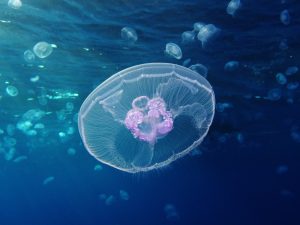
A Chinese mantis [photo by Ashley Bradford, taken from this site]:
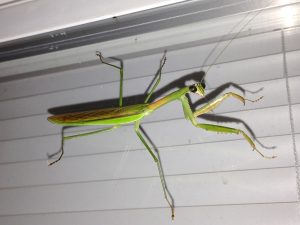
Also a Chinese mantis:
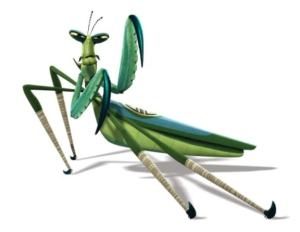
A type of octocoral:
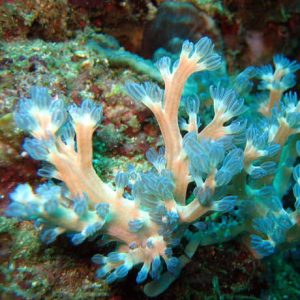
Show transcript:
Welcome to Strange Animals Podcast. I’m your host, Kate Shaw.
It’s finally Invertebrate August! We have some great episodes coming up this month, so let’s get started. Thanks to Kari and Joel for their suggestions this week!
First, we’ll start with an invertebrate from Kari Lavelle’s latest book, Butt or Face? Volume 2: Revenge of the Butts! It’s a sequel to the hilarious and really interesting book we talked about last summer. Kari kindly sent me a copy of the book and it’s just as good as the first one. Don’t worry, I won’t spoil the answer of whether the picture in the book is of an animal’s butt or face, but let’s talk about the moon jellyfish.
We’ve talked about jellyfish in several previous episodes, most recently in episode 343. Moon jellyfish is the term for jellies in the genus Aurelia, all of which look so identical that it takes close study by an expert, or a genetic test, to determine which species is which. We’re going to talk about a specific species in this episode, Aurelia aurita, but most of what we’ll learn about it also applies to the other moon jelly species.
Aurelia aurita lives in temperate, shallow water and is often found in harbors and close to shore. It’s mostly transparent and can grow up to 16 inches across, or 40 cm, although most are smaller. It’s sometimes called the saucer jelly because when its bell is open, it’s shaped sort of like a saucer or shallow bowl, if the bowl was upside down in the water with pinkish-white internal organs inside and short stinging tentacles. That’s most bowls, I think.
Unlike a lot of jellyfish, the moon jelly doesn’t have long tentacles that hang down from the middle of the bell. Instead, its tentacles are short and thin and line the edges of the bell. There are hundreds of them, but while the tentacles do have stinging cells, they’re not very strong. If you were to pet a moon jelly, you probably wouldn’t even feel the stings but you’d probably get sticky digestive mucus on your hands from the tentacles. The mucus is sticky to trap tiny pieces of food, which can include everything from fish eggs and various types of larvae to microscopic animals called diatoms and rotifers.
The moon jellyfish can survive in water with low oxygen, and in fact it prefers low oxygen water. Since most larger marine animals that live near the surface need a lot of oxygen to survive, the moon jelly can safely find its tiny food in low-oxygen areas without worrying too much about predators. Actually the moon jellyfish doesn’t worry about much of anything, because like other jellies, technically it doesn’t have a brain, just a nerve net.
Speaking of predators, for a long time scientists have wondered why anything bothers to eat jellies. They’re mostly water, which makes them easy for other animals to digest, but they contain almost no nutritional value. A study published in March 2023 determined that the bigger the jellyfish is, the more fatty acids its body contains, and fatty acids are an important nutrient. The main difference between a little jelly and a big jelly (besides size) is what they eat, so scientists think the bigger jellies are eating prey that contain more fatty acids, which slowly accumulate in the jelly’s body too.
Next, Joel sent a bunch of excellent suggestions for invertebrates, so many good ones I had trouble choosing which one to put in this episode. I chose the kung fu mantis because I love the Kung Fu Panda movies and think Mantis is an awesome character who is not appreciated enough.
Everyone loves praying mantises and we’ve talked about various species in different episodes, most recently episode 375. The one we’re talking about today is specifically called the Chinese mantis, Tenodera sinensis, which is native to Asia but which is invasive in parts of North America. It grows over 4 inches long, or about 11 cm, and is brown and green in color. It has a yellow spot between its raptorial arms, which as you can guess from the “raptor” part of that word are the arms with the big spikes that help it catch and kill its prey.
The reason this mantis is also called the kung fu mantis is because its ferocity and grace when hunting inspired a style of martial arts in China hundreds of years ago. The story goes that a great hero called Wang Lang was defeated in a duel, and afterwards set himself to study and train harder. One day he noticed a bird trying to catch a praying mantis, but the mantis was so skilled in defending itself against a much larger opponent that the bird eventually gave up and flew away. Wang Lang was inspired to incorporate the mantis’s movements into kung fu, and afterwards he never lost a duel.
Like other mantises, the Chinese mantis will eat pretty much anything it can catch. That’s mostly insects and spiders, but occasionally it will eat frogs and other amphibians, lizards and other reptiles, and occasionally even small birds. It’s a good insect to have around the garden because it eats so many garden pests, but it also eats bees and butterflies, which isn’t so good for the gardener. The Chinese mantis also eats other mantises, which is a problem in North America where it will kill and eat the native mantis species. But because the Chinese mantis is easy to keep in captivity, if you order mantises to release in your garden in the United States, as a natural pest control, there’s a good chance that the species is actually the Chinese mantis. The native Carolina mantis looks very similar but is smaller, only about 2.5 inches long, or 6 cm.
The Chinese mantis also eats other Chinese mantises. You may have heard about how the praying mantis female will bite the male’s head right off after or even while they’re in the process of mating, and then she’ll just eat him up for a nice big meal to help her develop her eggs. This is actually something that happens, although not always. In the case of the Chinese mantis, scientific observations have found that the female eats the male about half the time.
Let’s finish with a type of coral you may not have heard of, octocoral, also called soft coral. We’ve mentioned corals lots of times in various episodes but we haven’t really discussed them in detail. When most people think of coral they think of stony corals that make up coral reefs. Most corals are colonial animals, meaning each individual polyp grows together in a group, and stony coral polyps form a type of exoskeleton or shell made of calcium carbonate to protect its soft body. The polyps have small tentacles that they extend into the water to catch plankton and other particles of food, although some species are larger and can even grab little fish. The tentacles contain stinging cells called nematocysts that can stun or even kill small animals. As the colony grows, with old polyps dying and young polyps attaching to the hard skeletons left behind, the reef gets larger and larger as the years pass.
Not all stony corals live in shallow warm water and build reefs. Some live in cold water and deeper water, and there are even deep-sea corals, and these types of coral don’t build reefs. Octocorals don’t build reefs and are found in both shallow and deep water, and they don’t form hard skeletons.
Instead, the polyps of octocoral form a soft tissue full of tiny channels that allow water through. Octocorals are colonial, so the tissue of each polyp blurps together with those of all the other polyps around it. Some species of octocoral secrete little pieces of harder material to help the tissue keep its shape, but most species are still overall quite soft. It’s strong, though, and the tiny channels through it allow water to carry nutrients to all the polyps.
The octocoral gets its name because it has exactly eight tentacles, although the tentacles are feathery in appearance with lots of little branches growing off the main tentacle. This allows it to catch more tiny food. Some octocorals have long, elaborate tentacles, which has earned them the names sea fans and sea pens, from the old-timey days when pens were made from big feathers.
Corals in general appear in the fossil record for about half a billion years, with stony corals more likely to preserve for obvious reasons. Many species of octocoral exhibit bioluminescence, and that leads us to a recent study, published in April 2024.
Until this new study, scientists estimated that the first bioluminescent creatures lived around 250 million years ago. Bioluminescence has evolved separately over 100 times, though, and is found today in animals as different as fungus and fish. For the new study, scientists analyzed the genetics of 185 octocoral species to see how they were related, and then compared their findings with fossil corals to learn more about when the species split from their common ancestors. That gave them a good idea of when octocorals might have evolved originally and hinted at which ancestors were bioluminescent. They estimated that the first octocoral evolved around 540 million years ago and was already bioluminescent!
The scientists who worked on the study suggest that bioluminescence may have developed originally as a byproduct of other chemical reactions, but it was useful to the animal by possibly attracting food or other octocorals. Bioluminescence is common in marine animals these days, especially in deep-sea animals, so it’s possible that the ocean half a billion years ago was filled with lights from octocorals and many other organisms.
You can find Strange Animals Podcast at strangeanimalspodcast.blubrry.net. That’s blueberry without any E’s. If you have questions, comments, or suggestions for future episodes, email us at strangeanimalspodcast@gmail.com. We also have a Patreon at patreon.com/strangeanimalspodcast if you’d like to support us for as little as one dollar a month and get monthly bonus episodes.
Thanks for listening!
